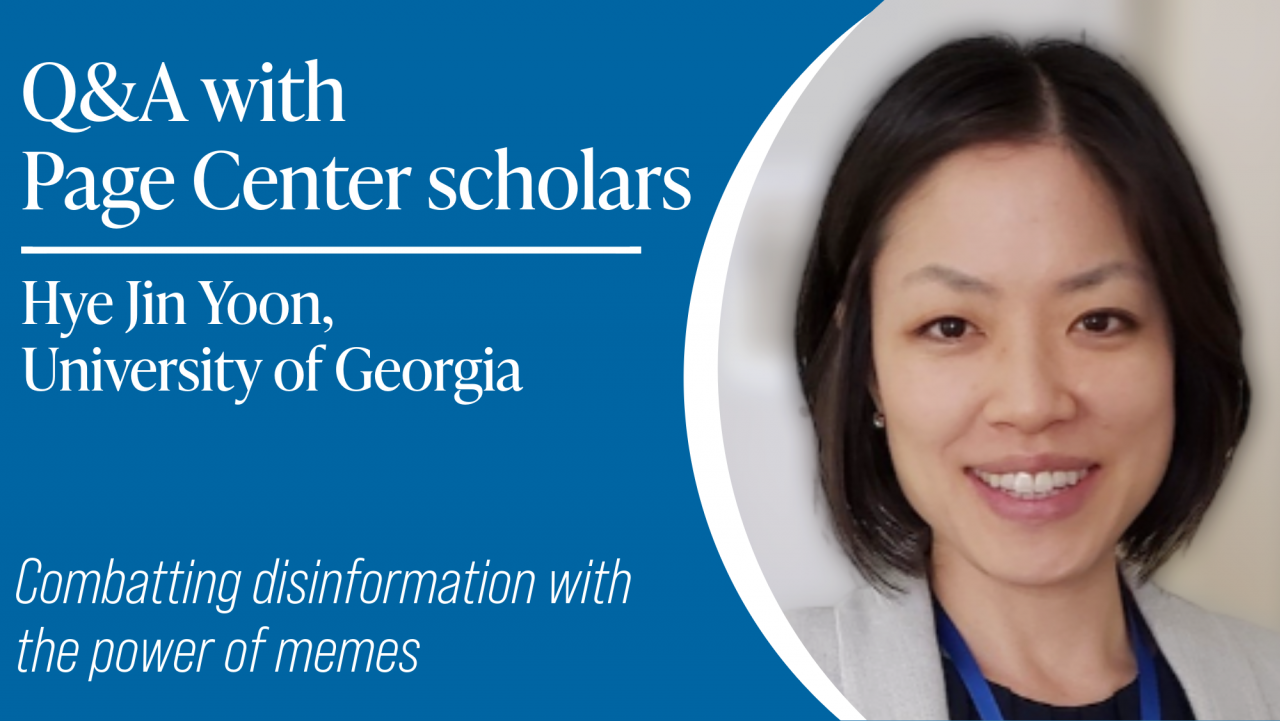November 05, 2024
Channeling the power of memes to combat disinformation – Scholar Q&A with Hye Jin Yoon

Whether it’s an image, text or a video, a meme can be an alarmingly effective driver of disinformation. Two Page Center scholars are looking to, in a way, fight fire with fire. Hye Jin Yoon, University of Georgia, and Yan Huang, University of Houston are exploring the use of memes – particularly humorous ones – as a strategy to combat disinformation campaigns. By leveraging cognitive dissonance theory, they aim to undermine and discredit bad actors who intentionally share disinformation. Yoon is a first-time Page Center scholar and Huang is a three-time scholar. Their project is part of the Page Center’s 2024 research call on expanding theory for integrity in public communication. In this Q&A, Yoon talks about humor and memes, where theory fits in and the expected practical implications from this project.
Your research interests focus on humor and advertising and Yan’s focus is on disinformation and misinformation. How did you come together as collaborators, and how did your collaboration lead to this project?
I was working at Southern Methodist University. I no longer work at SMU, but when I was there, we hired my co-PI Yan Huang. I was on the search committee. Yan had a more strategic mass communication background, but our department was advertising. We got to talking, and we really hit it off. We worked together and then stayed in touch after leaving our previous jobs. Yan became a huge expert in disinformation and misinformation. She introduced me to the idea of applying for a grant from the Page Center. So, we asked, ‘If memes are being used for disinformation dissemination, can we use them to fight against disinformation too?’
Can you briefly explain the difference between misinformation and disinformation and why you’re focusing on disinformation?
There is a lot of work done on misinformation, which is spread by people who don’t know that the information is false. They actually believe it, which makes it hard to attack. That is why we are going after the disinformation side of things, where the actors are actual bad players who know what they are doing. They are driving their agenda by misleading the public on purpose.
This is a theory project but has a lot of practical use as well. Can you talk about how theory fits in and how it could lead to practical results?
If you don’t have a strong theory to build your case on, it’s very hard to test anything. We are bringing in cognitive dissonance theory to test our hypotheses, which we think provides a strong theoretical foundation for this experimental work. It’s actually a very hard theory to test, because it is difficult to measure cognitive processes. We plan to explore the emotional responses associated with cognitive dissonance, such as discomfort, denial or anger to assess the underlying cognitive dissonance of disinformation. We think this will provide a solid basis for our studies on using memes and humor to combat disinformation.
You’ll be approaching this theory in two different ways. Can you explain the two studies and your plans for them over the next year?
The goal is to test how the level of covertness or overtness of the disinformation source impacts the cognitive and emotional responses. The first study focuses on a covert disinformation source, for example, Big Oil and the disinformation campaign around plastic recycling. We think this covert disinformation source that is not widely known will create more cognitive dissonance when exposed, as people may have a harder time believing they have been misled.
For study two, we are examining an overt disinformation source, using the example of e-cigarette companies. We hypothesize that this more well-known disinformation source will create more of a cognitive consonance state, where people are able to accept that the source is untrustworthy and dismiss the information. Our goal is to test how the level of covertness or overtness of the disinformation source impacts the cognitive and emotional responses, based on cognitive dissonance theory.
From the practical end, what are your expectations for communicators? What do you think they could learn from this study and how could they use it to combat disinformation?
I was invited to give a talk on humor and risk communication to a group of scholars and practitioners. During the talk, I mentioned this Page Center grant and our work on disinformation campaigns using memes and humor. This sparked a lot of interest and questions from the audience. They wanted to know how government organizations and agencies could use memes to combat misinformation. The previous expert who spoke to the group had advised that they should not try to fight misinformation directly and should instead just focus on disseminating good information. The people in the room felt pretty hopeless that they couldn’t do something more proactively. I think this highlights the need for more unconventional strategies, such as using memes to combat disinformation.
Fighting disinformation is hard, but being funny is hard too. Could humor be on job descriptions at some point?
It's funny because when I was at SMU, there was a humor conference that happened there. It was professors from linguistic departments, computer science departments, and language professors that study humor. They’d crack a joke here and there, but they were very serious about humor. For three days they discussed humor in serious ways.
But yes, it is a difficult subject to tap into, because who finds something funny is very subjective. Coming up with stimuli is hard. If you really investigate the humor literature, there's so many different types of humor, which, even as a humor scholar who's been doing this for 14-15 years, I find it hard to distinguish one type of humor from another. I'm looking more at how we merge a broader humor process with societal challenges while communicating to the public in different ways and mixing traditional messaging strategies with humor in different contexts.
